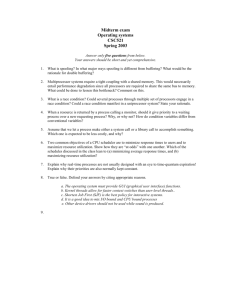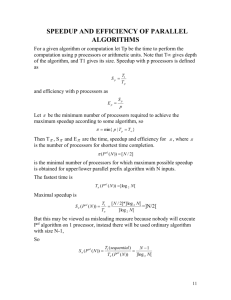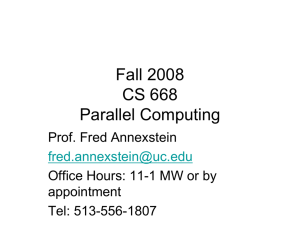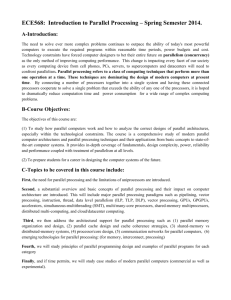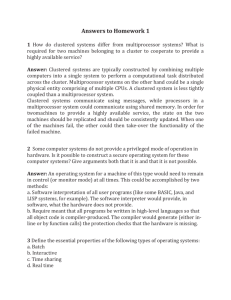cs492_2_shared_memory
advertisement
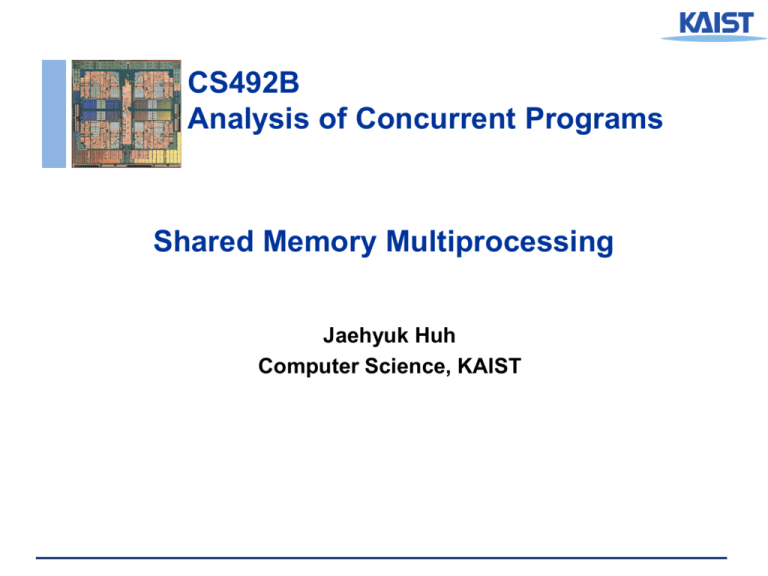
CS492B
Analysis of Concurrent Programs
Shared Memory Multiprocessing
Jaehyuk Huh
Computer Science, KAIST
Limits of Uniprocessors
• Era of uniprocessor improvement: mid 80s to early 2000s
– 50% per year performance improvement
– Faster clock frequency at every new generation of technology
• Faster and smaller transistors
• Deeper pipelines
– Instruction-level Parallelism (ILP) : speculative execution + superscalar
– Improved cache hierarchy
• Limits of uniprocessors : after mid 2000s
– Increasing power consumption started limiting microprocessor designs
• Limits clock frequency
• Heat dissipation problem
• Need to reduce energy
– Cannot keep increasing pipeline depth
– Diminishing returns of ILP features
Diminishing Returns of ILP
• Get harder to extract more ILP already picked lowhanging fruits of ILP…
• Control dependence (imperfect branch prediction)
• Slow memory (imperfect cache hierarchy)
• Inherent data dependence
• Significant increase of design complexity
Performance
Number of Transistors
Efforts to Improve Uniprocessors
• More aggressive out-of-order execution cores
– Large instructions window: a few hundreds or even thousands in-flight
instructions
– Wide superscalaer 8 or 16 way superscalar
– Invest large area to increase front-end bandwidth
– Mostly research effort, not yet commercialized never?
• Data-level parallelism (vector processing)
–
–
–
–
Bring back traditional vector processors
New stream computation model
Apply similar computations to different data elements
SSE (in x86), Cell processors, GPGPU
• Uniprocessor performance is still critical effort to
improve it will continue
Advent of Multi-cores
• Aggregate performance of 2 cores with N/2 transistors >>
performance of 1 core with N transistors
Performance
Number of Transistors
Power Efficiency of Multi-cores
• For the same aggregate performance
– 4 Cores with 600MHz consumes much less power than 2 cores with
1.2GHz
Power Consumption Incr(%)
(Normalized to Best conf.)
• 𝑷𝒕𝒐𝒕𝒂𝒍 = 𝑷𝒅𝒚𝒏𝒂𝒎𝒊𝒄 + 𝑷𝒔𝒕𝒂𝒕𝒊𝒄
≈ 𝜶 ∙ 𝑪 ∙ 𝑽𝟐 ∙ 𝒇 + 𝑽 ∙ 𝑰𝒍𝒆𝒂𝒌
1.6
1.4
1.2
1
Normalized to
3Core 600MHz 100%
Normalized to
3Core 400MHz 100%
Parallelism is the Key
• Multi-cores may look like a much better design than a
huge single-core processor both for performance and
power efficiency
• However, there is a pitfall It assumes the perfect
parallelism.
– Performance parallelism: N-core performance == N x 1-core performance
• Can we achieve the perfect parallelism always?
• If not, what make parallelism imperfect?
Flynn’s Texonomy
• Flynn’s classification by data and control (instruction)
streams in 1966
• Single-Instruction Single-Data (SISD) : Uniprocessor
• Single-Instruction Multiple-Data (SIMD)
– Single PC with multiple data Vector processors
– Data-level parallelism
• Multiple-Instruction Single-Data (MISD)
– Doesn’t exist…
• Multiple-Instruction Multiple-Data (MIMD)
–
–
–
–
Thread-level parallelism
In many contexts, MIMD = multiprocessors
Flexible: N multiple programs or 1 programs with N threads
Cost-effective: same CPU (core) in from uniprocessors to N-core MPs
SIMD and MIMD
Communication in Multiprocessors
• How processors communication with each other?
• Two models for processor communication
• Message Passing
– Processors can communicate by sending messages explicitly
– Programmers need to add explicit message sending and receiving codes
• Shared Memory
– Processors can communicate by reading from or writing to shared
memory space
– Use normal load and store instructions
– Most commercial shared memory processors do not have separate private
or shared memory the entire address is shared among processors
Message Passing Multiprocessors
• Communication by explicit messages
• Commonly used in massively parallel systems (or large
scale clusters)
– Each node of clusters can be shared-memory MPs
– Each node may have own OS
• MPI (Message Passing Interface)
– Popular de facto programming standard for message passing
– Application-level communication library
• IBM Blue Gene/L (2005)
–
–
–
–
–
65,536 compute nodes (each node has dual processors)
360 teraflops of peak performance
Distributed memory with message passing
Used relatively low-power, low-frequency processors
Used MPI
MPI Example
MPI_Comm_size(MPI_COMM_WORLD,&numprocs);
MPI_Comm_rank(MPI_COMM_WORLD,&myid);
if(myid == 0) {
for(i=1;i<numprocs;i++) {
sprintf(buff, "Hello %d! ", i);
MPI_Send(buff, BUFSIZE, MPI_CHAR, i, TAG, MPI_COMM_WORLD);
}
for(i=1;i<numprocs;i++) {
MPI_Recv(buff, BUFSIZE, MPI_CHAR, i, TAG, MPI_COMM_WORLD, &stat);
printf("%d: %s\n", myid, buff);
}
} else {
MPI_Recv(buff, BUFSIZE, MPI_CHAR, 0, TAG, MPI_COMM_WORLD, &stat);
sprintf(idstr, "Processor %d ", myid);
strcat(buff, idstr);
strcat(buff, "reporting for duty\n");
/* send to rank 0: */
MPI_Send(buff, BUFSIZE, MPI_CHAR, 0, TAG, MPI_COMM_WORLD);
}
Shared Memory Multiprocessors
• Dominant MP models for small- and medium-sized
multiprocessors
• Single OS for all nodes
• Implicit communication by loads and stores
– All processors can share address space can read from or write to any
location
– Arguably easier to program than message passing
• Terminology: UMA vs NUMA
– UMA (Uniform Memory Access Time) : centralized memory MPs
– NUMA (Non Uniform Memory Access Time) : distributed memory MPs
• What happens to caches?
– Caches can hold copies of the same address
– How to make them coherent Cache Coherence Problem
• This class will focus on shared memory MPs
Contemporary NUMA
Comtemporary NUMA Multiprocesso
Shared Memory Example: pthread
int arrayA [NUM_THREADS*1024]
int arrayB [NUM_THREADS*1024]
int arrayC [NUM_THREADS*1024]
void *sum(void *threadid) {
long tid;
tid = (long)threadid;
for (i = tid; i < tid*1024; i++) {
arrayC[i] = arrayA[i] + arrayB[i];
}
pthread_exit(NULL);
}
int main (int argc, char *argv[]) {
...
for(t=0; t<NUM_THREADS; t++){
pthread_create(&threads[t], NULL, psum, (void *)t);
}
for(t=0; t<NUM_THREADS; t++){
pthread_join(threads[i],NULL);
}
}
Shared Memory Example: OpenMP
int arrayA [NUM_THREADS*1024]
int arrayB [NUM_THREADS*1024]
int arrayC [NUM_THREADS*1024]
#pragma omp parallel default(none) shared(arrayA,arrayB,arrayC) private(i)
{
#pragma omp for
for (i=0; i<NUM_THREADS*1024; i++)
arrayC[i] = arrayA[i] + arrayB[i];
} /*-- End of parallel region --*/
Performance Goal => Speedup
• SpeedupN =
ExecutionTime1 /
ExecutionTimeN
• Ideal scaling: performance
improve linearly with the
number of cores
17
What Hurt Parallelism?
• Lack of inherent parallelism in applications
– Amdahl’s law
• Unbalanced load in each core (thread)
• Excessive lock contention
• High communication costs
• Ignoring limitation of memory systems
Limitation of Parallelism
• How much parallelism is available?
– There are some computations hard to parallelize
• Example: what fraction of the sequential program can be
parallelized?
– Want to achieve 80% speedup with 100 processors,
– Use Amdahl’s Law
Speedup overall
80
1
1 Fraction
parallel
Fraction
Speedup
parallel
parallel
1
1 Fraction
– Fractionparallel = 0.9975
parallel
Fraction
100
parallel
Simulating Ocean Currents
(a) Cross sections
(b) Spatial discretization of a cross section
• Model as two-dimensional grids
– Discretize in space and time
– finer spatial and temporal resolution => greater accuracy
• Many different computations per time step
• set up and solve equations
– Concurrency across and within grid computations
• Static and regular
20
Limited Concurrency: Amdahl’s Law
• If fraction s of seq execution is inherently serial,
speedup <= 1/s
• Example: 2-phase calculation
– sweep over n-by-n grid and do some independent computation
– sweep again and add each value to global sum
• Time for first phase = n2/p
• Second phase serialized at global variable, so time = n2
Speedup <=
2n2
n2
+
n2
p
or at most 2
• Trick: divide second phase into two
– accumulate into private sum during sweep
– add per-process private sum into global sum
• Parallel time is n2/p + n2/p + p, and speedup at best
2n2
2n2 + p2
21
Understanding Amdahl’s Law
1
(a)
n2
n2
work done
concurrently
p
(b)
1
n2/p
n2
p
1
(c)
n2/p n2/p p
Time
22
Load Balance and Synchronization
Speedup problem(p) <
Sequential Work
Max Work on any Processor
P0
P0
P1
P1
P2
P2
P3
P3
• Instantaneous load imbalance revealed as wait time
– at completion
– at barriers
– at flags, even at mutex
Sequential Work
Max (Work + Synch Wait Time)
23
Improving Load Balance
• Decompose into more smaller tasks (>>P)
• Distribute uniformly
–
–
–
–
variable sized task
randomize
bin packing
dynamic assignment
• Schedule more carefully
– avoid serialization
– estimate work
– use history info.
P0
P1
P2
P4
24
Example: Barnes-Hut
(a) The spatial domain
(b) Quadtree representation
• Divide space into roughly equal # particles
• Particles close together in space should be on same processor
• Nonuniform, dynamically changing
25
Dynamic Scheduling with Task Queues
• Centralized versus distributed queues
• Task stealing with distributed queues
–
–
–
–
Can compromise comm and locality, and increase synchronization
Whom to steal from, how many tasks to steal, ...
Termination detection
Maximum imbalance related to size of task
All processes
insert tasks
P0 inserts
QQ
0
P1 inserts
P2 inserts
P3 inserts
Q1
Q2
Q3
P2 removes
P3 removes
Others may
steal
All remove tasks
(a) Centralized task queue
P0 removes
P1 removes
(b) Distributed task queues (one per process)
26
Impact of Dynamic Assignment
• Barnes-Hut on SGI Origin 2000 (cache-coherent shared memory)
:
30
Origin, semistatic
Challenge, semistatic
Origin, static
Challenge, static
25
30
Origin, dynamic
Challenge, dynamic
Origin, static
Challenge, static
25
20
15
10
Speedup
Speedup
20
15
(a) 0
10
5
5
1 3 5 7 9 11 13 15 17 19 21 23 25 27 29 31
Number of processors
(b) 0
1 3 5 7 9 11 13 15 17 19 21 23 25 27 29 31
Number of processors
27
Lock Contention
• Lock: low-level primitive to regulate access to shared data
– acquire and release operations
– Critical section between acquire and release
– Only one process is allowed in the critical section
• Avoid data race condition in parallel programs
– Multiple threads access a shared memory location with an undetermined
accessing order and at least one access is write
– Example: what if every thread executes total_count += local_count, when
total_count is a global variable? (without proper synchronization)
• Writing highly parallel and correctly synchronized
programs is difficult
– Correct parallel program: no data race shared data must be protected
by locks
Coarse-Grain Locks
• Lock the entire data structure correct but slow
• + Easy to guarantee the correctness: avoid any possible
interference by multiple threads
• - Limit parallelism: only a single thread is allowed to
access the data at a time
• Example
struct acct_t accounts [MAX_ACCT]
acquire (lock);
if (accounts[id].balance >= amount) {
accounts[id].balance -= amount;
give_cash();
}
release (lock)
Fine-Grain Locks
• Lock part of shared data structure more parallel but
difficult to program
• + Reduce locked portion by a processor at a time fast
• - Difficult to make correct easy to make mistakes
• - May require multiple locks for a task deadlocks
• Example
struct acct_t accounts [MAX_ACCT]
acquire (accounts[id].lock);
if (accounts[id].balance >= amount) {
accounts[id].balance -= amount;
give_cash();
}
release (accounts[id].lock)
Cache Coherence
• Primary communication mechanism for shared memory
multiprocessors
• Caches keep both shared and private data
– Shared data: used by multiple processors
– Private data: used by single processors
– In shared memory model, usually cannot tell whether an address is private
or shared.
• Data block can be any caches in MPs
– Migration: moved to another cache
– Replication: exist in multiple caches
– Reduce latency to access shared data by keeping them in local caches
• Cache coherence
– make values for the same address coherent
HW Cache Coherence
• SW is not aware of cache coherence
– HW may keep values of the same address in multiple caches or the main
memory
– HW must support the abstraction of single shared memory
• Cache coherence communication mechanism in shared
memory MPs
– Processors read from or write to local caches to share data
– Cache coherence is responsible for providing the shared data values to
processors
• Good cache coherence mechanisms
– Need to reduce inter-node transactions as much as possible i.e. need to
keep useful cache-blocks in local caches as long as possible
– Need to provide fast data transfer from producer to consumers
Coherence Problem
• Data for the same address can reside in multiple caches
• A processor updates its local copy of the block write
must propagate through the system
P2
P1
u=?
$
P3
3
u=?
4
$
5
$
u :5 u = 7
u:5
I/O devices
1
u :5
2
Memory
Processors see different values for u after event 3
Propagating Writes
• Updated-based protocols
– All updates must be sent to the other caches and the main memory
– Send writes for each store instruction huge write traffics through the
networks to other caches
– Can make producer-consumer communication fast
• Invalidation-based protocols
–
–
–
–
To update a block, send invalidations to the other caches
Writer’s copy : modified (dirty state)
Other copies : invalidated
If other caches access the invalidated address cause a cache miss and
writer (or memory) must provide the data
– Used in most of commercial multiprocessors
Update-based Protocols
• Wasting huge bandwidth
– Temporal locality of writes: may send temporary updates (only the final
write need to be seen by others)
– Updated block in other caches may not be used
– Takes long to propagate write since actual data must be transferred
P2
P1
P3
3
$
$
$
u :5 u: 7
1
u :5 u = 7
u: 7
u :5
Memory
I/O devices
2
Invalidation-based Protocols
• Send only invalidation message with command/address
• No data are transferred for invalidation
• Data are transferred only when needed
– Save network and write traffics to caches
– May slow down producer-consumer communication
P2
P1
P3
3
$
$
$
u :5 invalidation
1
?
u :5
Memory
u :5 u = 7
I/O devices
2
False Sharing
• Unit of invalidation: cache blocks
– Even if only part of cache block is updated need to invalidate the entire
block
• What if two processors P1 and P2 read and write different
parts of the same cache block?
– P1 and P2 may repeatedly invalidate
cache blocks in the caches
– Known as false sharing
• Solution
P2 read and write this word
1
2
3
P1 read and write this word
– Programmers can align data structure properly to avoid false sharing
4
Understanding Memory Hierarchy
• Idealized view: local cache hierarchy + single main
memory
• But reality is more complex
– Centralized Memory: caches of other processors
– Distributed Memory: some local, some remote + network topology
– Levels closer to processor are lower latency and higher bandwidth
38
Exploiting Temporal Locality
• Structure algorithm so working sets map well to hierarchy
– often techniques to reduce inherent communication do well here
– schedule tasks for data reuse once assigned
• Multiple data structures in same phase
– e.g. database records: local versus remote
• Solver example: blocking
(a) Unblocked access pattern in a sweep
(b) Blocked access pattern with B = 4
•
More useful when O(nk+1) computation on O(nk) data
•
Many linear algebra computations (factorization, matrix multiply)
39
Exploiting Spatial Locality
• Besides capacity, granularities are important:
– Granularity of allocation
– Granularity of communication or data transfer
– Granularity of coherence
• Major spatial-related causes of artifactual communication:
– Conflict misses
– Data distribution/layout (allocation granularity)
– False sharing of data (coherence granularity)
• All depend on how spatial access patterns interact with dat
a structures
– Fix problems by modifying data structures, or layout/alignment
40
